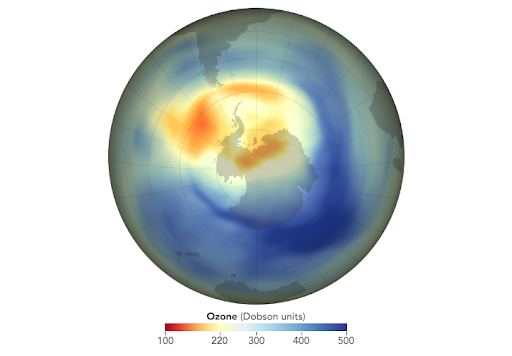The widespread use of certain chemicals changed our atmosphere’s chemical composition and created a hole in the UV-deflecting ozone layer above us. Our researchers continue to keep track of the hole and their observations show that it has grown in size since last year.
Earth.Org takes a closer look.
—

The Antarctic ozone hole observed this year, 2020, shows a more significant deterioration of ozone than in 2019, but still is an improvement from its peak destruction in the early 2000s. (Source: NASA Earth Observatory Image, developed from data gathered by NASA Ozone Watch and Global Modelling and Assimilation Office)
For close to 50 years, a hole has formed above the Antarctic continent, with rather significant health and ecological implications. The ozone layer serves as a protective shield against the sun’s ultraviolet (UV) radiation, where exposures can result in increased risks of skin cancers. First used for fridges in 1928, it was not until the 1970s that scientists realised chlorofluorocarbons (CFCs) could react with atmospheric ozone, producing oxygen and depleting the protective ozone layer. Once this was established, a global effort was made to combat the use of CFCs in household applications like refrigeration units, air conditioning, and aerosol cans. The Vienna convention for the protection of the ozone layer, first formed in 1985, represented the first global effort to combat human-driven climatological effects.

The extent of ozone depletion in 2019 was the smallest in almost 40 years of satellite records and observations. (Source: NASA Earth Observatory Image, developed from data gathered by NASA Ozone Watch and Global Modelling and Assimilation Office).
After countries agreed to phase out CFCs under the Vienna convention, the hole in the ozone layer kept growing until the year 2000. During this period, however, bromine and chlorine levels in the Antarctic stratosphere declined by 16%. Fast forward to 2019, and the ozone hole had diminished to its smallest since the 1980s at a peak area of 16.4 million km2. This year, research found that the hole’s size also depends on meteorological factors, and not only the chemical composition of the atmosphere.

At 23.3 million square kilometers, the average size of the ozone hole between Sept. 7 and Oct. 13 used to compare to other years, 2020’s ozone hole is the 12th largest by area. Credits: NASA/NASA Ozone Watch/Katy Mersmann.
The NASA Ozone Watch team determined that the peak area of the ozone hole in 2020 was around 24.8 million km2, ranking it 12th largest by area since satellite records of the Antarctic ozone layer began. Influenced by cold temperatures and strong circumpolar winds, these factors affected the formation of polar stratospheric clouds (PSCs), whose particles activate CFC compounds and lead to more ozone depletion. This came in contrast with 2019 when warm temperatures and comparatively weak circumpolar winds hampered the formation of these clouds. Scientists note that the decrease in atmospheric CFC means that ozone depletion this year was far less drastic than if these weather patterns had occurred 20 years ago.
The hole in the ozone layer remains one of the big environmental problems to tackle in the 21st century. We regularly launch weather balloons up into the hole to monitor ozone levels, and its lowering rates of depletion are encouraging.
This article was written by Javier Chai Rui Cheng.
You might also like: Ozone Layer Restoration Is Back on Track as Harmful Chemicals Phased Out, UN Says










![The Statistics of Biodiversity Loss [2020 WWF Report]](https://u4d2z7k9.rocketcdn.me/wp-content/uploads/2020/12/lprwinkyTHB-544x306.jpg)





